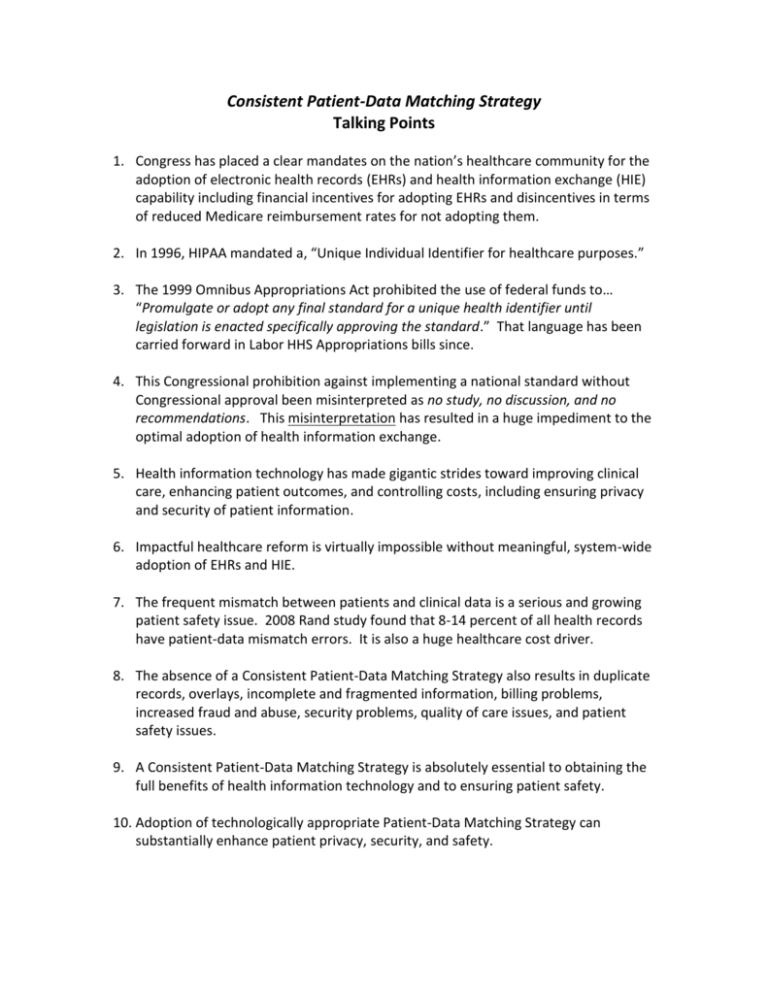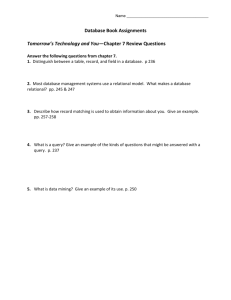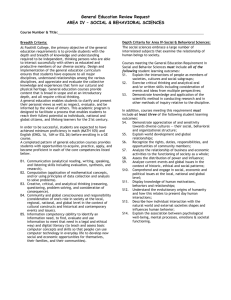Informed National Level Patient_ID Solution
advertisement

Consistent Patient-Data Matching Strategy Talking Points 1. Congress has placed a clear mandates on the nation’s healthcare community for the adoption of electronic health records (EHRs) and health information exchange (HIE) capability including financial incentives for adopting EHRs and disincentives in terms of reduced Medicare reimbursement rates for not adopting them. 2. In 1996, HIPAA mandated a, “Unique Individual Identifier for healthcare purposes.” 3. The 1999 Omnibus Appropriations Act prohibited the use of federal funds to… “Promulgate or adopt any final standard for a unique health identifier until legislation is enacted specifically approving the standard.” That language has been carried forward in Labor HHS Appropriations bills since. 4. This Congressional prohibition against implementing a national standard without Congressional approval been misinterpreted as no study, no discussion, and no recommendations. This misinterpretation has resulted in a huge impediment to the optimal adoption of health information exchange. 5. Health information technology has made gigantic strides toward improving clinical care, enhancing patient outcomes, and controlling costs, including ensuring privacy and security of patient information. 6. Impactful healthcare reform is virtually impossible without meaningful, system-wide adoption of EHRs and HIE. 7. The frequent mismatch between patients and clinical data is a serious and growing patient safety issue. 2008 Rand study found that 8-14 percent of all health records have patient-data mismatch errors. It is also a huge healthcare cost driver. 8. The absence of a Consistent Patient-Data Matching Strategy also results in duplicate records, overlays, incomplete and fragmented information, billing problems, increased fraud and abuse, security problems, quality of care issues, and patient safety issues. 9. A Consistent Patient-Data Matching Strategy is absolutely essential to obtaining the full benefits of health information technology and to ensuring patient safety. 10. Adoption of technologically appropriate Patient-Data Matching Strategy can substantially enhance patient privacy, security, and safety. 11. Technology has achieved quantum advances in privacy and security technologies to protect personal data. Additionally, Congress is updating national privacy and security standards, data breach notification requirements, and penalties. 12. In the absence of a Consistent Patient-Data Matching Strategy as the use of electronic health records and health information exchange expands, the multitude of different solutions becomes increasingly built into our health information infrastructure. 13. Without a Consistent Patient-Data Matching Strategy the marketplace has adopted differing local and regional approaches to patient-data matching resulting additional barriers to system-wide health information exchange. 14. A technologically advanced and consistent Patient-Data Matching Strategy will help control costs and enhance business processes including claims processing, coordination of benefits, referral certification, auditing, identity theft prevention, and detecting health fraud, waste, and abuse. 15. The Coalition does not advocate any specific solution or approach to the issue of Patient identity Integrity but rather simply recommends that – a. The Labor HHS Appropriations Bill language clearly does not prohibit the study, discussion, and making recommendations on a Consistent PatientData Matching Strategy. b. Therefore, Congress should direct a thorough study to evaluate the cost/benefit and practicality of implementing informed national-level patient identity solutions. The GAO could provide such an unbiased study. 16. The objectives of a patient-data matching study should include: a. The prevalence and costs of patient-data mismatches nation-wide including the costs of correcting these errors. b. The patient safety risks of NOT having national patient identity solution. c. The benefits and implications of applying patient identity solutions in healthcare. d. Current and near-term available technologies and best practices for assuring patient-data matching while enhancing patient information privacy and security. e. The costs/benefits and practicality of applying nation-wide patient identity solutions.











